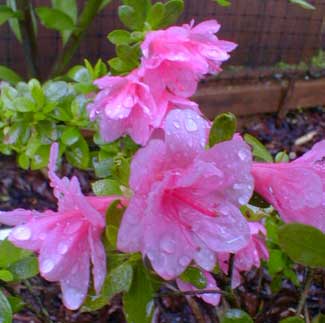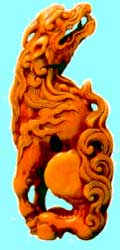
'Kirin' or 'Coral Bells'
Pink Hose-in-Hose Azalea
"Blooming azaleas
in a hollow on a cliff.
A Buddha stands."
-Masaoki Shiki
(1867-1902)
(1867-1902)
A hose-in-hose azalea is one for which every trumpet-shaped flower has a second trumpet-flower inside it. 'Coral Bells' (which has also been known as 'Daybreak' & 'Pink Beauty') is a small-leafed compact evergreen azalea with pink hose-in-hose blossoms in April.
It's a Japanese Kurume hybrid which might reach two feet height in ten years, but could remain smaller, though specimens of great old age can be six feet tall. It usually spreads wider than its height.
In Japan it is called 'Kirin,' after a mythological animal. Kirins vary in type, with traits similar to dragons, unicorns, & giraffes. The netsuke ornament shown on this page depicts a typical kirin. If you've ever had a Kirin beer from Japan, then you've seen the beast on the beer label.
 Japan's Kurume hybrids were first seen in America in 1915, when they were displayed at the Panama-Pacific Exposition in San Francisco, celebrating the opening of the Panama Canal.
Japan's Kurume hybrids were first seen in America in 1915, when they were displayed at the Panama-Pacific Exposition in San Francisco, celebrating the opening of the Panama Canal.Two Japanese Americans who founded the Domoto Brothers Nursery in Hayward, California, bought many of these plants at the Exposition. Eager to further exploit them commercially, the brothers visited the village of Kurume in 1917, & were soon importing thirty-two different Kurume azaleas, several of which are still popular, including 'Coral Bells.'
Two years later (in 1919) the Arnold Aboretum in Boston received fifty Kurume varieties through the efforts of Ernest "Chinese" Wilson who is sometimes wrongly stated to have been the first to introduce Kurumes to America. It was with the combined efforts of the Domoto brothers & the Arnold Arboretum that Kurumes made swift inroads into American nurseries, & their popularity has never since slackened.
Kurume azaleas, hybridized foremost from Rhododendron kaempferi, R. rikiusianum, & R. obtusum, have sacred origins going back more than three hundred years. R. obtusum, however, is no longer regarded as a wild species, but as a hybrid of R. satense, R. kiusianum, while R. kaempferi occurs both naturally in the wild & as very old Japanese garden hybrids.
The complex hybridization began with plants collected from the 5,500 foot tall volcanic Mount Kirishima on the island of Kyushu, southernmost of Japans four main islands. Long before they were called Kurume azaleas they were called Kirishima azaleas. Modern chemical analysis of Kurume azaleas has established that as legend states, they really are related to wild populations on the sacred mountain.
Kirishima is multi-peaked so is more than one mountain, & various of its craters have collectively erupted sixty-seven times since 742 A.D. From prehistory to the modern age Kirishima has been regarded as a place of the kami spirits or gods. The mountain is especially sacred to Ninigi, the son of the Goddess Amaterasu. Ninigi's first home when he descended from heaven was Mount Kirishima. He became the grandfather of the first mikado or emperor of Japan, & to him every mikado since has traced his ancestry.
A shrine called Kirishima Jingu has been destroyed at least sixty times by the mountain's eruptions. The present structure was rebuilt in 1482. From Kirishima Jingu one can view the primeval forest. The azaleas of the sacred forests belong to the mountain's divinities & are grown for divine honor & beauty.